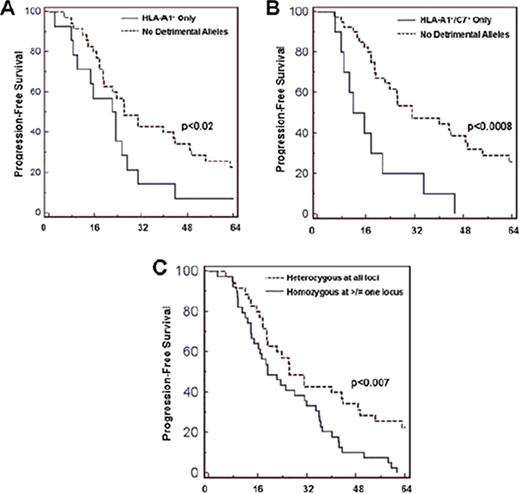Abstract
Abstract 1370
Though the cancer immune surveillance hypothesis was first proposed a century ago, there has been limited evidence to support the role of antigen presentation in the detection or suppression of CLL. In this study we evaluated the frequencies of HLA haplotype and homozygosity and subsequent impact on clinical outcome in CLL patients with advanced disease.
We performed a retrospective chart review of 249 CLL patients who were referred for allogeneic stem cell transplant at MD Anderson Cancer Center. We compared HLA allele frequencies of the patient population with those of local, race-matched controls and identified specific HLA alleles which were more frequent in the patient population. We also compared HLA homozygosity between the patient and control population. The Kaplan-Meier method was then used to determine the prognostic significance of the identified HLA alleles and homozygosity on clinical outcome within our patient population. Progression-free survival (PFS) was calculated from the time of first treatment to the time of progression or death.
CLL patients with advanced disease were significantly more likely to express HLA-A1 (OR=1.49, 95% CI 1.15–1.94, p=0.0003) or HLA- C7 (OR 1.24, 95% CI 1.00–1.53, p=0.05). In addition, these patients were more likely to be homozygous at any HLA locus than were controls (OR=1.20, 95% CI 0.97–1.48, p=0.04), particularly at HLA-C (OR=1.62, 95% CI 1.13–2.33, p=0.002) and at multiple HLA loci (OR=1.69, 95% CI 1.06–2.70, p=0.006). CLL patients who were HLA-A1+, HLA-A1/C7+ or homozygous at any allele demonstrated worse PFS in comparison with CLL patients without any of these HLA allelic characteristics. Median survival was 23.9 months for HLA-A1+ patients, 13.9 months for HLA-A1/C7+ patients and 25.7 months for patients with homozygosity, in comparison to 31.8 months for the population without any detrimental alleles or homozygosity (p=0.02, p=0.0008, and p=0.007 respectively, Figure 1: A, B, C). Analysis of patients possessing only HLA-C7 as a risk factor demonstrated a trend toward decreased PFS but was not quite statistically significant (p=0.07, data not shown).
Patients with advanced CLL appear to express certain HLA alleles and exhibit HLA homozygosity more frequently than normal controls. In addition, these HLA characteristics may predispose CLL patients to a worse outcome. Because HLA allelic variation determines the specificity of antigens presented to the immune system, the data suggest that immune surveillance may play a physiologic role in the control of leukemic disease and provide a theoretical framework for the identification of CLL antigens which could eventually serve as targets for immunotherapy.
A. Negative effects of HLA-A1 allele on overall survival of patients with advanced CLL are B. synergistically worsened by the presence of the HLA-C7 allele. C. Homozygosity at any HLA allele also imparted a negative impact upon overall survival.
O'Brien:Novartis: Research Funding; BMS: Research Funding.
Author notes
Asterisk with author names denotes non-ASH members.


